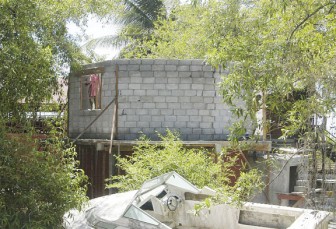The Celina Atlantic Resort building violates the Sea Defence Act and permission for its construction should not have been granted, according to former Chief Hydraulics Officer and Specialist Engineer for Sea Defences Malcolm Alli.
Alli, in an e-mail, told Stabroek News that he had designed and built the section of the sea defence in 1968, following massive erosion of the foreshore.
He explained that where Celina sits, to the north of the seawall next to the Kitty Pump Station, was the grouted boulder slope, below which has built up silt. The Celina building, he said, is built over this silt, which can disappear overnight by erosion, causing the building’s foundation to collapse and damaging the seawall.
Ali has said that on account of severe erosion on the East Coast during the late 1960s, Parliament on the advice of he and other engineers in the Hydraulics Division amended the Sea Defence Act, preventing construction of buildings and other structures in several areas of the coast landwards from 50 feet to 1000 feet from the centre line of the sea dam.
He has also noted that only in rare cases is permission granted by the Sea Defence Board to build minor structures—for religious purposes—seaward of the sea dam, and the responsibility to remove same during an erosion cycle rests with the owners. Alli also expressed concern over the fact that the government has dumped boulders on the upper level of the bitumen grouted Georgetown seawall, which was constructed in 1972. This wall, Alli stated, from Groyne to Camp Road, was not designed for heavy concentrated point loads but instead only for wave rush. He added that this loading can cause the bitumen to crack, ultimately exposing the seawall to the elements and destruction.

If this occurs, Alli said that Georgetown will be permanently flooded while there will be nowhere else to re-locate the sea defences.
“This government in my opinion is out to destroy what they have not built,” Alli stated. He noted that the seawall was built at a cost of US$11M.
The resort is located in an environmentally sensitive area, which has prompted questions about the danger its recent expansion poses to the courida and mangrove trees in the area. Some time ago, when Stabroek News had noted large quantities of construction material being ferried to the location, it had approached an official of the resort on whether expansion works were being done. The official at the time denied this and said only repair work to the decking and other areas were being done. Entirely new structures are, however, being put up and sources note that these would have to be approved by various agencies and the possible repercussions to the environment and the integrity of the sea defence in the area considered.
Engineer Bert Carter had previously opined that no one should be allowed to build any structure beyond the seawall, given the potential threat to sea defences while late engineer Melvyn Sankies said he thought the building was an obstruction. He explained that in the case of any emergency or disaster, full access is needed in that area.




